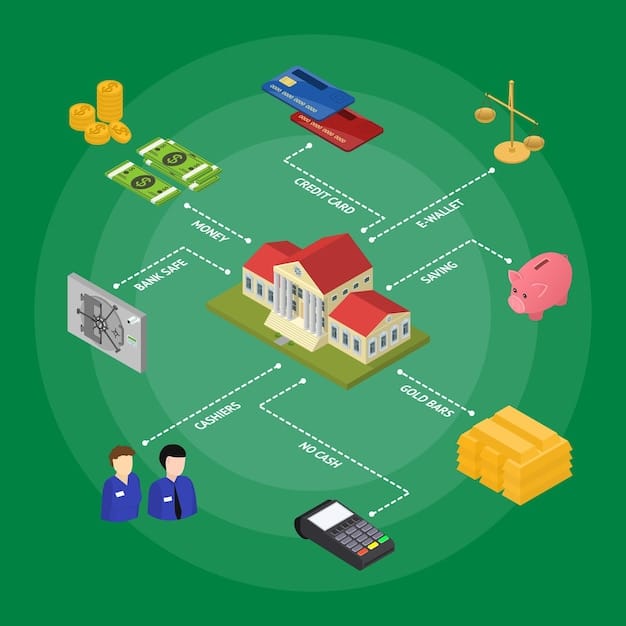DeFi Flash Loans: Your Beginner’s Guide to US Arbitrage

DeFi flash loans are uncollateralized lending options in the decentralized finance space, enabling users to borrow funds instantly for arbitrage opportunities and other strategies, provided the loan is repaid within the same transaction block.
Navigating the world of decentralized finance (DeFi) can seem daunting, especially when concepts like flash loans come into play. This guide aims to demystify DeFi flash loans, focusing specifically on how they can be leveraged for arbitrage opportunities within the US market.
Understanding DeFi Flash Loans
Flash loans are a unique feature of the DeFi ecosystem, allowing users to borrow funds without providing any upfront collateral. This might sound risky, but the key to their functionality lies in smart contracts. The loan must be repaid within the same transaction block it was taken out. If repayment fails, the entire transaction is reversed, effectively undoing the loan and any related operations.
In essence, flash loans provide a powerful tool for traders, developers, and other participants in the DeFi space, enabling sophisticated strategies that would otherwise be impossible or impractical.
How Flash Loans Work
The process behind a flash loan is quite elegant. A user initiates a transaction on a DeFi platform that supports flash loans. The smart contract disburses the requested loan amount to the user. The user then executes their planned operations—such as arbitrage trading—within the same transaction. Finally, the user repays the loan plus any associated fees to the smart contract. If all steps are completed successfully within the same block, the transaction is confirmed. If any step fails, the entire transaction is reverted, ensuring the lender’s funds are never at risk.
- Instant Borrowing: No collateral is required, making it accessible to anyone.
- Single-Transaction Execution: All actions must occur within a single blockchain block.
- Smart Contract Automation: The loan process is entirely governed by pre-defined smart contract rules.

With flash loans, the possibilities are vast, from arbitrage to collateral swapping and even self-liquidation. It’s a dynamic element in the world of DeFi.
Arbitrage Opportunities with Flash Loans in the US
Arbitrage involves exploiting price differences for the same asset across different markets. In the DeFi space, these price discrepancies can occur between various decentralized exchanges (DEXs). Flash loans enable traders to capitalize on these arbitrage opportunities by providing the necessary capital to execute trades quickly and efficiently.
The US market, with its diverse range of DeFi platforms and users, presents a fertile ground for flash loan-driven arbitrage.
Identifying Price Discrepancies
To successfully execute arbitrage with flash loans, one needs to identify price differences between different DEXs. This can be done through various tools and platforms that track real-time pricing data across multiple exchanges. Many market participants develop custom scripts and bots to automate this process, alerting them to potential arbitrage opportunities as they arise.
These tools constantly monitor the prices of different cryptocurrencies on various DEXs. When a significant price difference is identified, an arbitrage trade becomes possible.
- Real-Time Data: Monitor pricing across various DEXs.
- Automated Tools: Use bots and scripts to detect discrepancies.
- Alert Systems: Set up notifications for significant price differences.
For instance, if a trader notices that the price of ETH is higher on Uniswap than on SushiSwap, they can use flash loans to buy ETH on SushiSwap and sell it on Uniswap, pocketing the difference as profit.
Risks and Challenges of Using Flash Loans
While flash loans offer incredible opportunities, they are not without their risks. One of the primary concerns is the possibility of smart contract vulnerabilities. If the smart contract governing the flash loan has a bug, it could be exploited, leading to loss of funds. Additionally, the complexity of executing flash loan transactions requires a high level of technical expertise. Market volatility and transaction costs also pose significant challenges.
Successfully using flash loans requires a good understanding of the DeFi ecosystem, smart contracts, and risk management. Here are essential points you should consider.
Smart Contract Vulnerabilities
Smart contracts are the backbone of flash loans, and vulnerabilities in these contracts can lead to severe consequences. Hackers can exploit flaws in the code to drain funds or manipulate the loan process. Therefore, it is crucial to only use flash loans from reputable platforms with audited smart contracts.
Regular audits and security checks are necessary to identify vulnerabilities before malicious actors can exploit them. Open-source contracts also allow for community review and testing. This reduces the risk of problems within the coding.
- Audited Contracts: Use flash loans from audited platforms to minimize the risk of smart contract vulnerabilities.
- Community Review: Look for open-source contracts so they can be reviewed by the community.
- Regular Security Checks: Look for the platform’s track record in conducting security checks.

It’s not enough to rely solely on the platform; users should also educate themselves about the risks and review the smart contract code when possible.
Platforms Offering Flash Loans in the US
Several DeFi platforms offer flash loans, each with its own characteristics and requirements. Some of the popular platforms include Aave, dYdX, and Uniswap. These platforms provide the infrastructure and smart contracts necessary to execute flash loans. However, the availability and specific terms of flash loans may vary depending on the platform and market conditions.
Each platform has different fees, supported assets, and a wide range of features. Choosing the right platform requires careful consideration of your goals and risk tolerance.
Aave
Aave is one of the most well-known DeFi lending platforms, offering flash loans with a variety of supported assets. Aave’s flash loans are permissionless and can be integrated into any smart contract. This allows developers to create custom financial applications.
Aave charges a small fee for flash loans, typically around 0.09%, which is paid back along with the borrowed funds.
dYdX
dYdX is a decentralized trading platform that also offers flash loans. dYdX is particularly popular among traders looking to execute complex strategies, such as arbitrage and liquidation.
dYdX flash loans can be used for a range of purposes, including margin trading and collateral swapping. They are suitable for traders who need access to large amounts of capital for very short periods.
Legal and Regulatory Considerations for DeFi Flash Loans in the US
The legal and regulatory landscape for DeFi is still evolving, particularly in the United States. Flash loans, being a relatively new and innovative financial instrument, fall into a gray area. Regulators are closely monitoring the DeFi sector, and future regulations could significantly impact the use of flash loans. Compliance with existing laws, such as securities regulations and anti-money laundering (AML) rules, remains crucial.
Understanding these considerations is vital for ensuring the legality and sustainability of one’s DeFi activities.
Current Regulatory Environment
The current regulatory environment regarding DeFi is still uncertain. US regulators, such as the Securities and Exchange Commission (SEC) and the Commodity Futures Trading Commission (CFTC), have expressed concerns about the risks associated with DeFi protocols.
These agencies are actively exploring ways to regulate the space to protect investors and prevent illicit activities.
- SEC Scrutiny: The SEC is examining whether certain DeFi tokens qualify as securities, which would subject them to securities regulations.
- CFTC Oversight: The CFTC is focused on derivatives trading within the DeFi ecosystem, particularly those involving leverage.
- AML Compliance: DeFi platforms must comply with anti-money laundering regulations, including KYC (Know Your Customer) requirements.
DeFi participants should stay informed about the latest regulatory developments and seek legal advice to ensure they comply with applicable laws.
Best Practices for Using Flash Loans Safely
To safely and effectively use flash loans, one must adhere to certain best practices. This includes conducting thorough research, understanding smart contract risks, managing transaction costs, and staying informed about market conditions. Diversification of strategies and risk management are also key to mitigating potential losses.
Adopting these practices will minimize risk and maximize profits in the DeFi realm.
Thorough Research and Due Diligence
Before using flash loans, it is essential to conduct thorough research. This includes understanding the DeFi platform, the smart contracts involved, and the potential risks. Reviewing audit reports, testing the platform on a testnet, and understanding how the platform handles risk are useful steps.
Being well informed provides a solid foundation for making sound decisions and mitigating potential risks.
| Key Point | Brief Description |
|---|---|
| 💡 Instant Loans | Borrow funds without collateral, repay in one transaction. |
| ⚖️ Arbitrage | Exploit price differences on DEXs for profit. |
| 🛡️ Risk | Smart contract vulnerabilities and market volatility. |
| 🏛️ Regulations | Evolving legal landscape, SEC and CFTC monitoring. |
Frequently Asked Questions (FAQ)
▼
DeFi flash loans provide instant access to capital without collateral, making arbitrage and other complex strategies accessible to a wider range of users. They also enable efficient capital utilization and reduce the need for traditional lending intermediaries.
▼
Arbitrage opportunities can be found by monitoring price differences for the same asset across various decentralized exchanges. Tools and bots can automate this process, providing real-time data and alerting you to potential profit opportunities.
▼
The primary risks include smart contract vulnerabilities, market volatility, regulatory uncertainty, and transaction costs. It is crucial to use platforms with audited contracts and manage risk through diversification and thorough research.
▼
Flash loans currently operate in a legal gray area in the US. Regulators are monitoring the DeFi space, and future regulations could impact their use. Compliance with existing laws, such as AML rules, is essential to ensure legality.
▼
Several DeFi platforms offer flash loans, including Aave, dYdX, and Uniswap. Each platform has its own characteristics, supported assets, and fees, so choose the one that best meets your needs and risk tolerance.
Conclusion
DeFi flash loans offer a unique and powerful tool for traders and developers in the US, enabling arbitrage opportunities and other advanced financial strategies. However, it’s crucial to understand the risks involved and adhere to best practices to use them safely and effectively. Staying informed about regulatory developments and conducting thorough research are essential for navigating the ever-evolving DeFi landscape.





